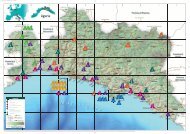Genovesato (Genoese area) - Turismo in Provincia di Genova
Genovesato (Genoese area) - Turismo in Provincia di Genova
Genovesato (Genoese area) - Turismo in Provincia di Genova
You also want an ePaper? Increase the reach of your titles
YUMPU automatically turns print PDFs into web optimized ePapers that Google loves.
GENOVESATO<br />
TRACES OF HISTORY<br />
The Great Walls of the Superba<br />
Fort Diamante Fort Pu<strong>in</strong><br />
20<br />
The new city walls were constructed around<br />
the higher parts of the city (1626-1639), to<br />
protect the city centre from attacks from the<br />
franco/piedmont military forces; they<br />
stretched, on the eastern side, from the<br />
mouth of the Bisagno River to the Peralto<br />
Mount, and to the west up until the<br />
Lighthouse. Totall<strong>in</strong>g almost 20 km <strong>in</strong> length,<br />
and re<strong>in</strong>forced by 18 forts, they were<br />
constructed tak<strong>in</strong>g advantage of the natural<br />
defences provided by the mounta<strong>in</strong>ous<br />
amphitheatre just beh<strong>in</strong>d Genoa. Most of the<br />
city walls have been destroyed, but most of<br />
the forts, and some of the large city gates and<br />
military works of defence, rema<strong>in</strong> <strong>in</strong>tact. The<br />
entire <strong>area</strong> (800 hectares) is now the Urban<br />
City Wall Park (www.forti-genova.com),<br />
where Me<strong>di</strong>terranean scrub gradually gives<br />
way to holms and hop hornbeams, as one<br />
ascends up the mounta<strong>in</strong>. There are squirrels,<br />
boars and foxes liv<strong>in</strong>g <strong>in</strong> this park and it is a<br />
stopover for migratory species of birds, such<br />
as the short toed eagle and the honey<br />
buzzard. It is easily reached by car or with the<br />
cable cars of Granarolo or Righi. You can get<br />
there on foot, follow<strong>in</strong>g the traces of the old<br />
military road which ran from fort to fort. It is<br />
an evocative walk which takes up almost a day.<br />
Once hav<strong>in</strong>g climbed up to Righi, you can walk<br />
along the l<strong>in</strong>e of the Mura delle Chiappe, up to<br />
the Fort of Castellaccio, then, follow the <strong>di</strong>rt<br />
roads and paths to Fort Sperone, which rises up<br />
from a peak of the homonymous Mount. It’s<br />
possible to visit Fort Pu<strong>in</strong> (1815-30) and Fort<br />
Diamante, the highest po<strong>in</strong>t of the excursion<br />
(667 m), and the furthest out posted of the<br />
defence system, featur<strong>in</strong>g a double star<br />
fortification. It’s possible to return from Fort<br />
Sperone by mak<strong>in</strong>g a little detour which leads<br />
to Fort Begato (1818-36), Fort Castellaccio<br />
(early ’800's) and Fort Tenaglia (1815-36)<br />
before return<strong>in</strong>g to the city. Along the cliff tops<br />
which jo<strong>in</strong> up the forts, a complex system of<br />
trenches, embankments, drystone walls, and<br />
palisades are still visible. These helped defend<br />
the city from Austrian and French attacks,<br />
between 1756 and 1810. Fort Santa Tecla<br />
(1747 -51), located <strong>in</strong> the neighbourhood of<br />
San Fruttuoso, together with Fort Begato, is the<br />
only one to have been recently restored. In its<br />
more than 25 rooms, great halls and weapons<br />
room, the history of "La Superba” is retold.








